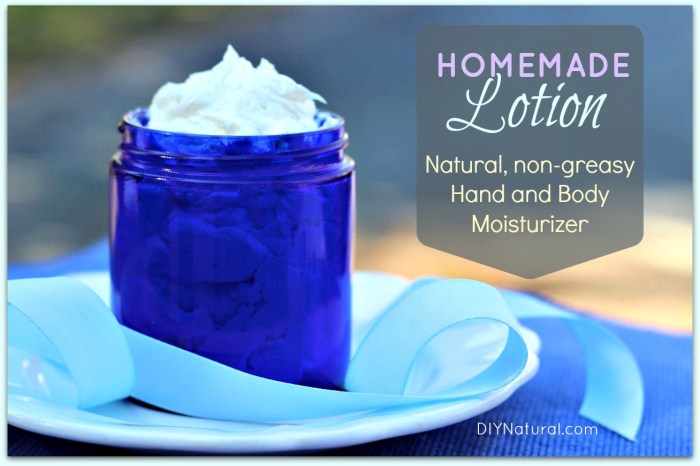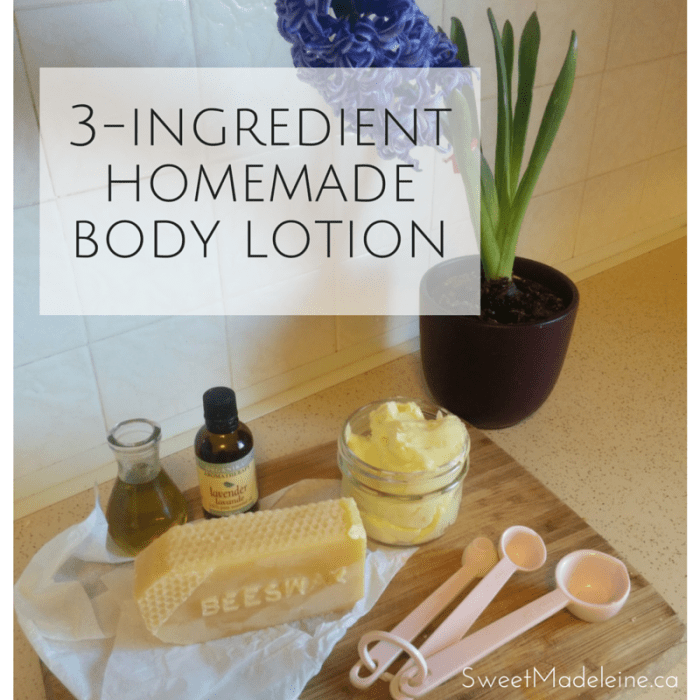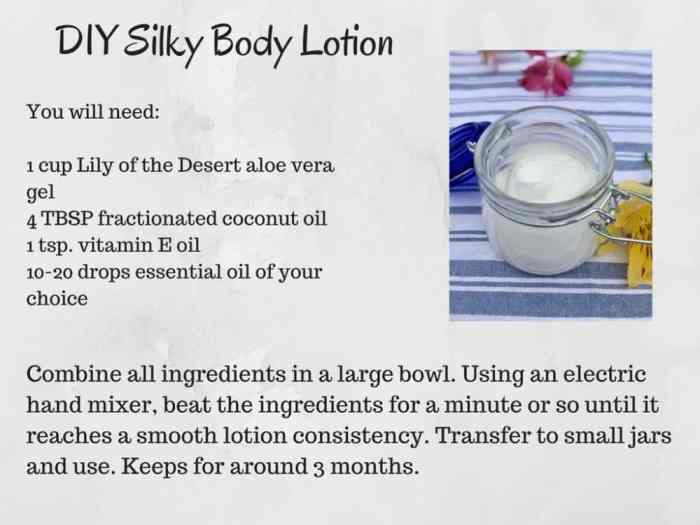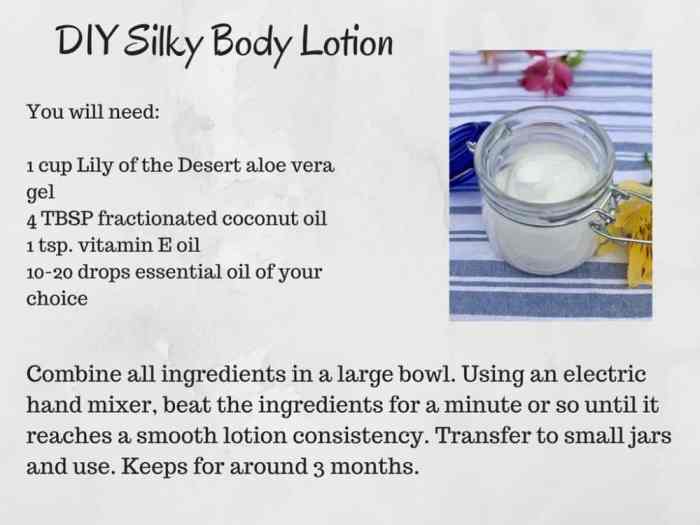DIY body lotion offers a personalized approach to skincare, allowing you to control the ingredients and create a product tailored to your specific needs. With a little effort and the right ingredients, you can craft a luxurious lotion that nourishes and pampers your skin, leaving it feeling soft and supple.
Table of Contents
This guide explores the benefits of making your own body lotion, provides essential ingredients and recipes, and delves into tips for creating a perfect blend for your skin type and concerns. Whether you’re seeking a simple, everyday lotion or a luxurious treatment, this comprehensive guide has you covered.
DIY Body Lotion Benefits

Creating your own body lotion offers a range of advantages, empowering you to control the ingredients and personalize your skincare routine.
Cost Savings
Making your own lotion can significantly reduce your skincare expenses. Commercial lotions often contain expensive ingredients and marketing costs, which are reflected in their prices. By using readily available ingredients like oils, butters, and essential oils, you can create high-quality lotion at a fraction of the cost. For example, a 100ml bottle of a premium body lotion from a well-known brand can cost around $20-$30, while homemade lotion using similar ingredients can be made for around $5-$10. This cost difference can be substantial, especially if you use lotion regularly.
Natural Ingredients, Diy body lotion
One of the primary benefits of DIY body lotion is the ability to use natural ingredients. This allows you to avoid harsh chemicals, artificial fragrances, and potential allergens often found in commercial lotions. Many natural ingredients, like shea butter, coconut oil, and aloe vera, have moisturizing and soothing properties that can benefit your skin. For example, shea butter is known for its rich emollients that deeply hydrate and nourish the skin, while aloe vera is renowned for its calming and anti-inflammatory properties.
Essential Ingredients: Diy Body Lotion

Creating your own body lotion is a rewarding experience, allowing you to customize it to your specific needs and preferences. The key is to choose the right ingredients that work together harmoniously to create a smooth, nourishing, and effective lotion.
The basic ingredients needed for a DIY body lotion include a base oil, an emulsifier, and water. These ingredients play crucial roles in creating the texture and functionality of your lotion.
Base Oils
Base oils form the foundation of your body lotion, providing nourishment and moisture to the skin. They are the primary carriers of essential oils or other additives. Here are some common base oils used in body lotion, along with their properties:
- Sweet Almond Oil: Rich in vitamin E and fatty acids, it is known for its moisturizing and soothing properties. It is a lightweight oil that absorbs easily into the skin.
- Jojoba Oil: A wax ester that closely mimics the skin’s natural sebum, it is non-comedogenic (won’t clog pores) and suitable for all skin types. It is known for its ability to balance oil production and hydrate the skin.
- Coconut Oil: This oil is rich in lauric acid, known for its antibacterial and antifungal properties. It is a good choice for dry skin as it provides deep hydration. However, it can be comedogenic for some individuals.
- Olive Oil: A rich source of antioxidants and vitamins, olive oil is known for its moisturizing and anti-aging properties. It can be heavy for some skin types.
- Avocado Oil: Rich in vitamins A, D, and E, avocado oil is known for its deep moisturizing and regenerative properties. It is suitable for dry, mature, and sensitive skin.
Emulsifiers
Emulsifiers are essential ingredients in body lotion that allow oil and water to mix and create a stable, smooth texture. They act as a bridge between the two phases, preventing separation and ensuring a consistent lotion.
Emulsifiers are substances that allow two immiscible liquids (like oil and water) to mix and form a stable emulsion.
Common emulsifiers used in DIY body lotion include:
- Beeswax: A natural emulsifier with moisturizing properties, it creates a thick and creamy texture.
- Shea Butter: A natural fat with excellent moisturizing and anti-inflammatory properties, it can also act as an emulsifier.
- Lecithin: A natural emulsifier derived from soybeans, it is known for its ability to create a light and easily absorbed lotion.
- Cetyl Alcohol: A fatty alcohol that acts as an emulsifier and thickener, it is often used in commercial lotions.
Basic Recipe

This simple DIY body lotion recipe is a great starting point for beginners. It uses readily available ingredients and can be easily customized to suit your preferences.
This recipe is designed to be straightforward and adaptable. You can adjust the quantities of ingredients based on your desired consistency and scent. It’s a great way to learn the basics of DIY body lotion making and experiment with different ingredients and variations.
Ingredients and Steps
This table Artikels the basic ingredients and steps involved in creating a simple DIY body lotion.
| Ingredient | Quantity | Description |
|---|---|---|
| Shea butter | 1/4 cup | Provides moisture and nourishment to the skin. |
| Coconut oil | 1/4 cup | Adds a silky texture and is easily absorbed by the skin. |
| Jojoba oil | 1 tablespoon | Mimics the skin’s natural sebum, making it a great choice for all skin types. |
| Aloe vera gel | 2 tablespoons | Soothes and hydrates the skin. |
| Essential oil (optional) | 10-15 drops | Adds a pleasant scent to your lotion. |
Here are the steps to create your DIY body lotion:
- Melt the Shea butter and coconut oil: In a double boiler or a heat-safe bowl over a pot of simmering water, melt the shea butter and coconut oil together until completely melted.
- Combine the oils and aloe vera gel: Remove the melted mixture from the heat and let it cool slightly. Add the jojoba oil and aloe vera gel to the mixture and stir well to combine.
- Add essential oil (optional): If using essential oil, add 10-15 drops to the mixture and stir well to distribute the scent evenly.
- Transfer to a container: Pour the lotion into a clean, airtight container.
- Store in a cool, dark place: Store your lotion in a cool, dark place, and it should last for several weeks.
Adjusting the Recipe
This basic recipe can be customized to suit your specific skin type and preferences.
- For dry skin: Increase the amount of shea butter and coconut oil to create a richer, more hydrating lotion.
- For oily skin: Reduce the amount of shea butter and coconut oil and add more aloe vera gel to create a lighter, less greasy lotion.
- For sensitive skin: Use unscented essential oils or skip them altogether. Choose hypoallergenic ingredients and patch test the lotion on a small area of skin before applying it all over.
Creating your own body lotion empowers you to take charge of your skincare routine, allowing you to enjoy the benefits of natural ingredients and customize your product for optimal results. With a little creativity and experimentation, you can craft a luxurious and effective lotion that leaves your skin feeling refreshed and revitalized.
Making your own body lotion can be a fun and rewarding experience, allowing you to customize the ingredients to your skin’s needs. While researching recipes, you might stumble upon articles about the potential benefits of certain natural oils, but it’s important to remember that self-treating with essential oils can be dangerous. If you’re experiencing anxiety or other mental health concerns, it’s crucial to consult a medical professional and avoid relying on unverified information.
For example, xanax dosages should always be determined by a doctor, never by online sources. Returning to DIY body lotions, remember to use high-quality ingredients and patch test any new formulas before applying them all over your body.


